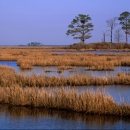About Us
First established in 1954 through a 2,569 acre donation by the late Glenn L. Martin, the Martin National Wildlife Refuge now covers 4,548 acres, including the northern half of Smith Island, 11 miles west of Crisfield, Maryland, and Watts Island, located between the eastern shore of Virginia and Tangier Island in lower Chesapeake Bay.
The tidal marsh, coves, creeks and ridges of Martin National Wildlife Refuge provide an important rest area and winter home for thousands of migratory waterfowl and nesting habitat for a variety of wildlife that change with the seasons.
Winter residents on the refuge include black ducks, pintail, mergansers, long-tailed ducks, scoters, bufflehead, Canada geese, and tundra swans. During spring and summer, the salt marsh salt marsh
Salt marshes are found in tidal areas near the coast, where freshwater mixes with saltwater.
Learn more about salt marsh grasses, abundant insects, and underwater vegetation attract black ducks, mallards, gadwall, and green-winged teal to nest on the refuge. Gulls, terns, black skimmers, oystercatchers, and willets nest and feed along the marsh grasses, mud flats, and sand bars. The wooded ridges provide nest sites for several water birds. Ten different species, including herons, egrets, and glossy ibis have been seen in rookeries on the refuge. Rookeries are groups or colonies of birds that nest together. Martin NWR supports the largest colony of brown pelicans in the Maryland portion of the Chesapeake Bay.
A small population of red fox, muskrat, mink, otter, voles, northern diamondback terrapin, and various nonpoisonous water snakes also live in the marsh areas. Clapper rails, sea-side sparrows, and marsh wrens also depend on the protected refuge habitat. Peregrine falcons have been nesting on the refuge every year since the first peregrine nesting tower was installed in 1984. The marsh and estuary are important in the production of marine species such as crabs and oysters that help form the food chain.
Our Mission
The mission of the National Wildlife Refuge System is "to administer a national network of lands and waters for the conservation, management, and where appropriate, restoration of the fish, wildlife, and plant resources and their habitats within the United States for the benefit of present and future generations of Americans.” —Refuge Improvement Act; Public Law 105-57
Our History
Martin National Wildlife Refuge (NWR) includes the northern half of Smith Island and Watts Island in the Chesapeake Bay. Smith Island is named after Captain John Smith, who explored and charted this and nearby islands in 1608. The acres of marsh grasses soon attracted settlers who raised cattle on the island, including parts of the refuge, until the 1950s. Evidence of low dikes built to hold back the tide, and corrals built for livestock, can still be seen today. Two early settlers of the island were John Evans and John Tyler. Evans and Tyler are still among the most common surnames of Smith Island residents.
For more than 300 years, Smith Island watermen have been making a living on the Bay, primarily from oysters and crabs. Dredging for oysters with "skipjacks" (sailboats specifically designed for oyster harvest) began around 1850. Their no-keel design and large mainsail make them very powerful and maneuverable. At one time, some 50 skipjacks were based on the island. Harvesting by power vessels came later and crab potting began around 1947. Today, residents of Smith Island continue the tradition of harvesting oysters in the winter and crabs in the summer.
Martin NWR was established in 1954 when the late Glenn L. Martin donated 2,569 acres to the U.S. Fish and Wildlife Service. Since then, through donation and purchase, the size of the refuge has increased to 4,548 acres. The tidal marsh, creeks and coves, and vegetated ridges of the refuge form an important stopover and wintering area for thousands of migratory waterfowl and nesting habitat for wildlife.
Other Facilities in this Complex
Martin National Wildlife Refuge is part of the Chesapeake Marshlands National Wildlife Refuge Complex.
